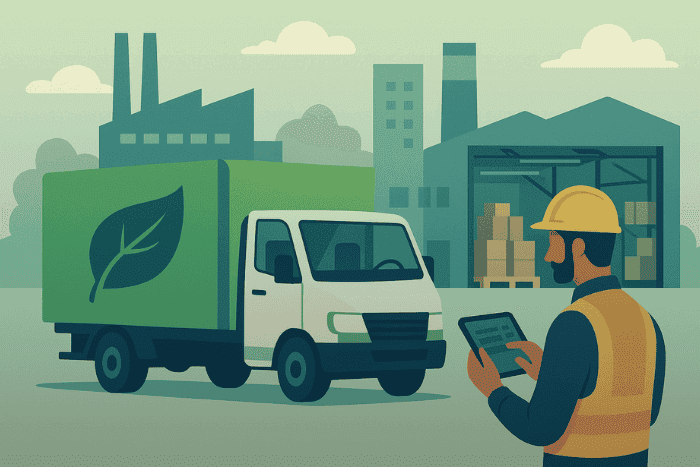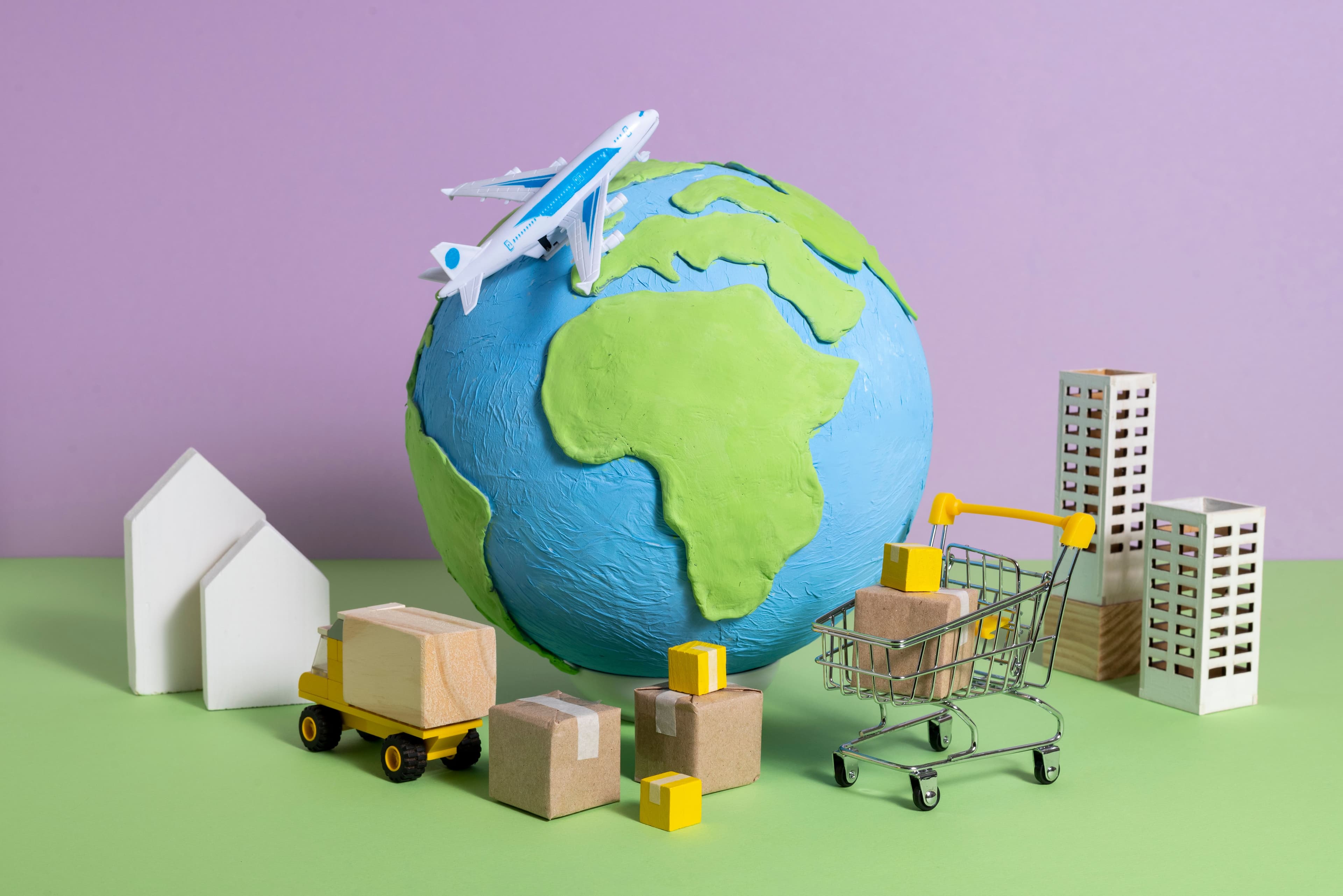Logistics is a major climate lever. Recent analysis shows freight logistics accounts for nearly half of transport-related emissions and 8% of global greenhouse gases, pressure that has grown alongside faster delivery expectations.
The good news: brands are moving from pledges to practice. Carbon-neutral shipping is increasingly offered as part of broader sustainability programs, paired with concrete emissions-reduction tactics (right-sizing, packaging choices, routing/last-mile optimization) before offsets close the gap.
In this article, you will learn what carbon-neutral shipping is, why it’s important, and how to build a carbon-neutral strategy.
Table of Contents:
- What Is Carbon Neutral Shipping?
- Why Is Carbon-Neutral Shipping Important?
- How to Build a Carbon Neutral Shipping Strategy
- Sustainable Practices in Manufacturing Transportation
- What Carbon Offsetting Techniques Actually Work?
- Common Mistakes in Carbon Neutral Shipping
- Key Takeaways
- Final Thoughts
- Frequently Asked Questions about Carbon Neutral Shipping
What Is Carbon Neutral Shipping?
Carbon-neutral shipping means reducing the carbon footprint of deliveries to zero on a net basis. Instead of treating emissions as an afterthought, it builds sustainability into everyday tasks, how you pack, the space you ship, and how trucks and vans move.
Organizations achieve this by reducing emissions inside the shipping process (right-sized packaging, less void fill, route optimization, consolidation, efficient returns, cleaner energy/vehicles) and balancing what remains with supporting actions that remove or reduce an equivalent amount of emissions outside the shipment’s footprint. Bringing the overall footprint back to net-zero.
Why Is Carbon-Neutral Shipping Important?
Carbon-neutral shipping matters because it aligns climate goals with day-to-day logistics. A reduce-first program can cut costs (less material waste, fewer DIM surcharges, better consolidation), build trust through transparent reporting, and keep brands ahead of tightening ESG and market expectations.
Myth-buster: Carbon neutrality is not limited to electric trucks or paperless labels; it’s about lowering total supply-chain impact, Scope 1, 2, and the elusive Scope 3 generated by carriers, warehouses, and raw-material suppliers.
For pharma and manufacturing, where temperature control, compliance paperwork, and clinical trial logistics add complexity, a balanced “reduce-first, neutralize-second” strategy safeguards both GDP and GMP standards while advancing sustainability in logistics and supply chain management.
Key Emission Sources in Pharma & Manufacturing Supply Chains
| Source | Typical % of logistics CO₂e | Cost Impact | What’s Happening |
|---|---|---|---|
| Parcel & small-freight transport | 35–55 % | Fuel surcharges, fast lanes | Frequent, smaller shipments, especially when urgent, can add up fast. |
| Sea & air pallet freight | 20–40 % | Route complexity, lane fees | Airfreight emits over 10× more CO₂ than ocean shipping, but is often used for speed. |
| Warehousing & cold storage | 10–20 % | Energy + refrigerants | Cold-chain operations like ultra-low temp freezers are energy-hungry. |
| One-off sample shipments | 5–10 % | Premium courier charges | Unbatched samples (common in trials) use expensive, high-emission options. |
Healthcare logistics is responsible for about 5% of global GHG emissions, and pharma is a big part of that. By understanding these common sources, your team can start linking carbon savings with cost savings, all while improving day-to-day operations.
How to Build a Carbon Neutral Shipping Strategy
Achieving carbon-neutral shipping starts with visibility, including how goods move within your facility. Without clear data on emissions, packaging, frequency, and costs, even the best-intentioned plans remain theoretical. A well-structured strategy requires four key pillars and the right tools to bring them to life.
1. Centralize Parcel Spend & Emissions Data
Uncontrolled parcel spend is one of the biggest blind spots in logistics operations. When employees create multiple FedEx or UPS accounts across locations, spend becomes fragmented, billing is opaque, and emissions reporting is nearly impossible.
Airpals’ Analytics Dashboard solves this by centralizing all carrier accounts into one platform, offering:
- Full cost transparency to identify unnecessary charges and optimize rate negotiations.
- Department-level tagging for each shipment, clinical trial kits, lab restocks, or cold-chain samples, to track CO₂e and budget impact in tandem.
- Visual analytics to detect low-weight parcels that could be grouped or redundant one-off shipments.
What used to require manual spreadsheets and guesswork can now be monitored in real time, enabling data-backed decisions that reduce both emissions and cost.
2. Partner with Sustainable Shipping Carriers
Vet your carriers not just on price, but on environmental alignment:
- Science-Based Targets (SBTi) or electrification roadmaps.
- API-level emissions reporting for shipment-level carbon data.
- Certified offset partnerships to neutralize unavoidable emissions.
Need help comparing services? Then check the guide titled: USPS vs UPS vs FedEx: Which Is Best in 2025?. It has all the info you need to understand which service provider works the best for you.
3. Optimize Packaging & Labels
Right-sizing packaging can significantly lower the carbon and cost burden of shipping. Switch to:
- Insulated, reusable pharma totes.
- Parcel combinations to avoid half-empty boxes.
- Integrated label tools to eliminate wasted time.
4. Offset Wisely, But Transparently
Not all carbon credits are created equal. Focus on third-party verified credits (e.g., Gold Standard, Verra) and prioritize those tied to reforestation, renewable energy, or carbon removal, not just avoidance schemes.
Make sure carbon offsetting supports your reduction goals, not replaces them.
5. Close the Loop: Report, Improve, Repeat
A sustainable strategy is one that evolves. Use the Airpals Analytics Dashboard to:
- Detect patterns like redundant one-off shipments, low-weight parcels, or underused consolidation opportunities.
- Set internal benchmarks and monitor progress over time, without relying on manual spreadsheets or disconnected carrier portals.
- Share visual reports with finance, operations, and ESG teams to support compliance and communicate results clearly.
Sustainable Practices in Manufacturing Transportation
When it comes to everyday shipping, small tweaks can lead to big carbon (and cost) wins:
- Consolidation & Milk-Runs: Instead of shipping whenever something’s ready, bundle recurring SKUs into regular weekly routes. These “milk-runs” help avoid half-empty trucks and wasted miles.
- Smarter Routes with AI: Let algorithms do the heavy lifting, AI-powered route planners can cut 8–15% off your total distance traveled, lowering both fuel spend and emissions.
- Greener Fleets & Smarter Modes: Not every shipment needs a diesel truck. Try mixing and matching for sustainability: Electric trucks for short local runs, rail or ocean freight for longer, non-urgent hauls, and biofuel options for legacy routes that can’t change overnight.
- Hold Your Vendors to a Higher Standard: Make sure your carriers and suppliers are on the same page. Add sustainability metrics, like CO₂e per kilogram or renewable energy usage, to your contracts and scorecards. Many top providers now offer real-time dashboards so you can track your emissions as easily as your shipments.
Clinical Trial Logistics: A Hidden Carbon Opportunity
Clinical trials don’t have to be a carbon headache. With a little planning, you can dramatically cut emissions without delaying doses or overwhelming your teams.
Here are a few simple moves trial coordinators can make:
- Send kits in batches, grouped by region, instead of rushing out one at a time.
- Choose eco-friendly carriers that give you clear CO₂ reports for each route.
- Build in “green lead-times” small calendar tweaks that help you stay sustainable without affecting patient care.
What Carbon Offsetting Techniques Actually Work?
When you’ve reduced emissions as much as possible, you can balance what’s left with proven carbon offsetting techniques:
- Reforestation & Afforestation: Restore or create forests that absorb CO₂ over time. Partner with programs that manage planting, monitoring, and long-term care.
- Renewable Energy Projects: Support wind or solar capacity that displaces fossil-fuel electricity generation and lowers grid emissions.
- Reduce package size: Use the smallest box that fits, skip excess padding, and combine items into one shipment when it makes sense. Less space and fewer materials = fewer emissions to balance later.
- Monitor your supply chain: Identify emissions within your supply chain to determine which tiers contribute the most to your carbon footprint. Fix the big levers: over-boxing, unnecessary air shipments, failed deliveries, so there’s less left to neutralize.
- Carbon Capture and Storage (CCS): Capture CO₂ from industrial sources and store it safely underground to keep it out of the air.
Common Mistakes in Carbon Neutral Shipping
- Relying only on offsets instead of reducing emissions first: Offsets are useful, but real impact comes from cutting emissions at the source.
- Overlooking Scope 3 emissions from carriers and suppliers: These hidden emissions often make up the largest share, so don’t leave them out.
- Assuming you need full emissions tracking to make progress: While not every company can calculate CO₂e precisely, using parcel management tools to cut redundant shipments and centralize spend is a strong first step toward reducing environmental impact.
- Choosing non-certified or questionable carbon credits: If credits aren’t verified by trusted standards, they may do more harm than good.
- Using oversized packaging for temperature-sensitive shipments: Extra insulation is important, but excessive packaging adds avoidable emissions and cost.
Key Takeaways
- Carbon neutral shipping demands both sustainable manufacturing practices and smarter logistics. Remember that offsets alone aren’t enough.
- Clinical trial logistics offer major reduction opportunities. Follow models like Novartis by consolidating shipments whenever possible.
- Visibility into parcel activity helps identify wasteful patterns and optimize operations.
- Choose eco-friendly transportation partners with efficiency programs that can help support sustainability goals.
- Use a phased roadmap: reduce emissions first, offset what remains. This approach protects your budget and compliance efforts.
- Upgrading parcel spend management gives teams the visibility needed to cut avoidable emissions, control costs, and support compliance efforts without adding operational burden.
Final Thoughts
Achieving carbon-neutral shipping isn’t a moon-shot. With centralized data, strategic carrier partnerships, and iterative optimization, pharma and manufacturing teams can weave sustainability in logistics and supply chain management into daily operations, lowering risk, cost, and emissions in one stroke.
Ready to turn insights into action? Discover how Airpals helps you uncover hidden inefficiencies, centralize parcel spend, and support your sustainability goals, all in one single dashboard. Get in touch with our team to learn how we can support your operations.

Frequently Asked Questions about Carbon Neutral Shipping
What is carbon neutral shipping?
Carbon neutral shipping is the process of calculating the greenhouse gas (GHG) emissions of a shipment, reducing them as much as possible, and offsetting the remaining emissions with certified carbon credits. The goal is to ensure the total environmental impact of each shipment equals zero across its full logistics lifecycle.
What is sustainability in the supply chain?
Sustainability in the supply chain means minimizing environmental impact from sourcing to delivery. It involves reducing emissions, energy use, water consumption, and packaging waste while maintaining quality and regulatory compliance. A sustainable supply chain supports long-term environmental and business performance.
Is carbon neutral shipping more expensive?
Carbon neutral shipping is not always more expensive. Cost-saving strategies like consolidating shipments, optimizing routes, and using right-sized packaging can reduce logistics expenses. These savings often offset the cost of verified carbon credits, making carbon-neutral practices both affordable and efficient.
How can pharma companies reduce shipping emissions?
Pharma companies can reduce shipping emissions by centralizing parcel spend, consolidating trial shipments, partnering with low-emission carriers, improving packaging efficiency, and offsetting residual emissions with certified credits. These actions support sustainability and compliance without affecting delivery performance.
What’s the difference between carbon neutral and carbon offset shipping?
The difference between carbon-neutral and carbon-offset shipping is in the approach. Carbon-neutral shipping focuses on reducing emissions first, then offsetting what remains. Carbon offset shipping often skips reduction and relies only on buying credits. Neutral shipping is more comprehensive and effective for long-term sustainability.




